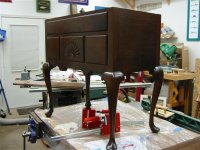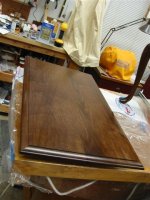I'm currently working on a lowboy I started in a class with Phil Lowe last summer (that'd be summer before last I guess! - I had other projects going). The carcas is glued up and standing on its own. I'm now working on the knee blocks. Something I ran into that I have done before, but never got a real good feel for is finishing up the intersection between the post and the knee. When you bandsaw, its hard to get them perfect and I think we cut these posts on the ts before we bandsawed the curves. Anyway, any tips on cleaning up this area? And while we are at it, these knees are the overlay type that rest on top of the apron - a first for me. Any tips on those?
Thanks for the help. I looked in the gallery and saw some really nice dressing tables/lowboys that are inspiring and great reference.
Tony - Memphis
Thanks for the help. I looked in the gallery and saw some really nice dressing tables/lowboys that are inspiring and great reference.
Tony - Memphis


